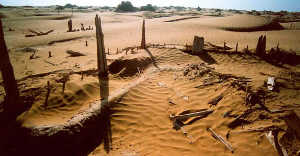|
Ancient City of Niya
( 2005-09-13 )
 Introduction Introduction
 The remains of the lost ancient city of Niya are believed to the ancient Jingjue Kingdom during the Han (206BC-220AD) and Jin (265-420) dynasties. The ancient Jingjue Kingdom was at the south end of the Silk Road, sprawling over an area 25 kilometers long from north to south and 5-7 kilometers wide from east to west. The remains of the lost ancient city of Niya are believed to the ancient Jingjue Kingdom during the Han (206BC-220AD) and Jin (265-420) dynasties. The ancient Jingjue Kingdom was at the south end of the Silk Road, sprawling over an area 25 kilometers long from north to south and 5-7 kilometers wide from east to west.
At the site, the ruins of house foundations, courtyards, tombs, stupas,temples, fields, orchards, channels, kilns, and smelting workshops among others have been excavated, together with a large quantity of cultural relics, including wood ware,bronze, pottery, stone ware, woolen articles, coins, and so on.
 History History
In 1959, a wool pile carpet fragment was unearthed at the site of Niya, on the southern edge of the Taklimakan Desert found along the Silk Road. The fabrication of the fragment discovered has been dated back to about 100 BC. The Niya Site is one of the most important archaeological sites in the Tarim Basin and is actually the site of the ancient Jingjue Kingdom.
No one can believe that there was a rich and varied community that once thrived deep in today's Taklimakan Desert some 1,600 years ago. Just like other places in China, it was then under the control of several officials appointed by the central government. There lived families with a population of more than 3,000 people.
Hover, despite at one point sprawling over an area 20 kilometers in circumference around what is now the dried bed of the Niya River, the city eventually became buried in the desert sand and slipped in oblivion. The extinction of Niya has left archaeologists and scientists many questions to answer. It has also given the ruins of the ancient holy city a feeling of mystery.
The Niya River winds through the southern Taklimakan Desert Desert for about 210 kilometers and its head waters are fed by melted snow from the toweringKunlun Mountain, known was Nan Mountain in ancient times. The river gradually dries up near a small Uygur village.
|

